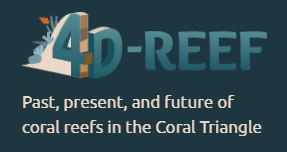
From September 2019 to August 2023, we will investigate the past, present, and future of coral reefs in the Coral Triangle. The program combines geo-, bio- and climate sciences; 15 Early Stage Researchers will form the backbone of the project, involving 11 international institutes.
Key questions
Using a variety of paleo-ecological and present-day data, 4D-REEF investigates the hypothesis that turbid coastal environments provide a refuge for coral reefs in periods of warm climate. The key questions to be addressed are:
1) What was the biodiversity of turbid reefs in the past and in what habitats did the reefs grow in past warmer periods of the Earth’s history, and how does this compare to the present?
2) What are the environmental constraints on ecosystem functions of turbid reefs?
3) How can we use information from past reefs to better understand the future trajectories of modern coral reefs, and apply this towards reef restoration actions?
By answering these questions, we aim to understand the role of turbid reefs for the future of marine ecosystems in the Coral Triangle as they respond to anthropogenic environmental change.
To address these questions, we will study reefs from three different time periods: modern reefs, reefs from the Holocene (10-5 thousand years ago) that developed prior to significant anthropogenic impact, and reefs from the Pliocene (roughly 3 million years ago) that might represent potential process analogues for future greenhouse conditions.
